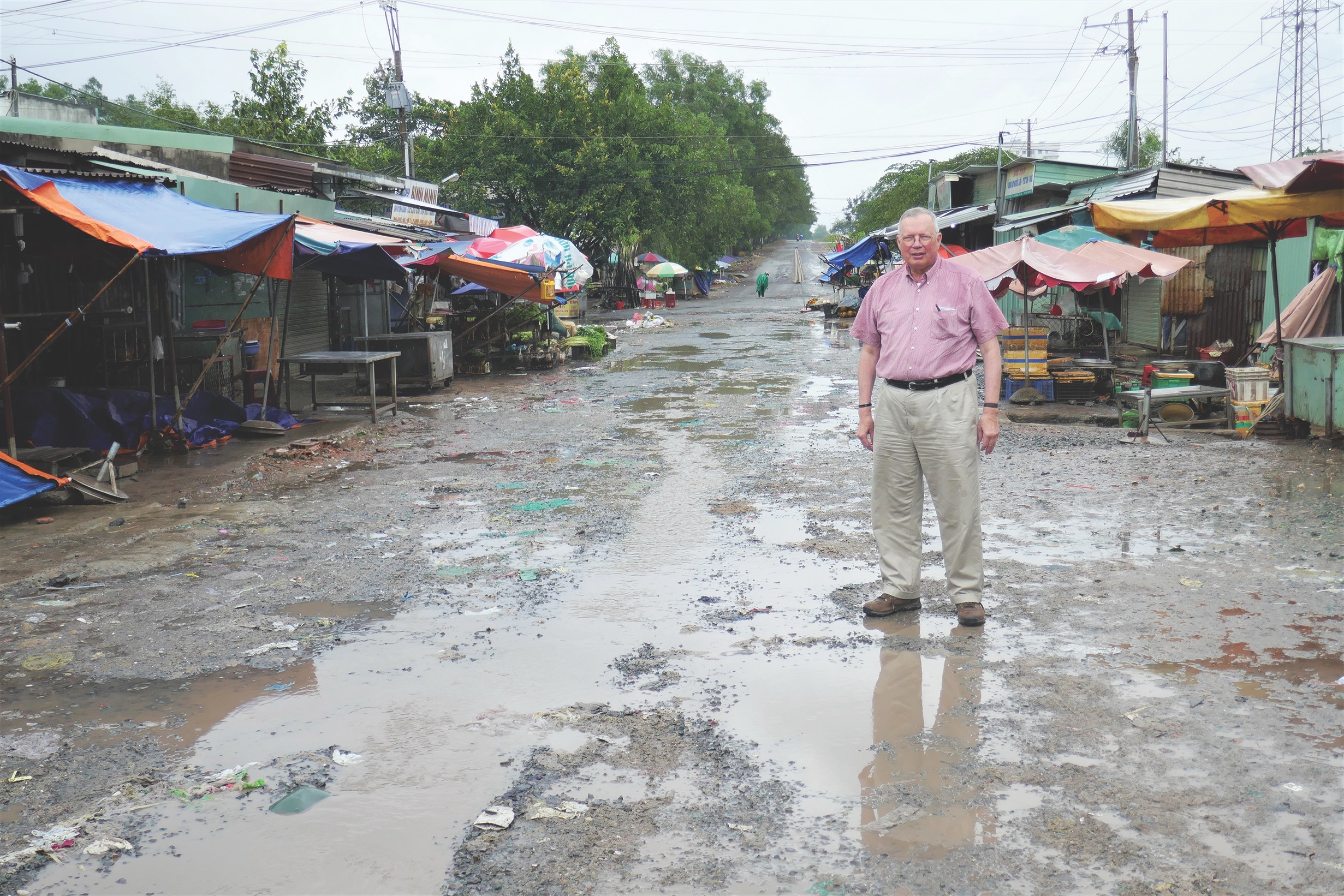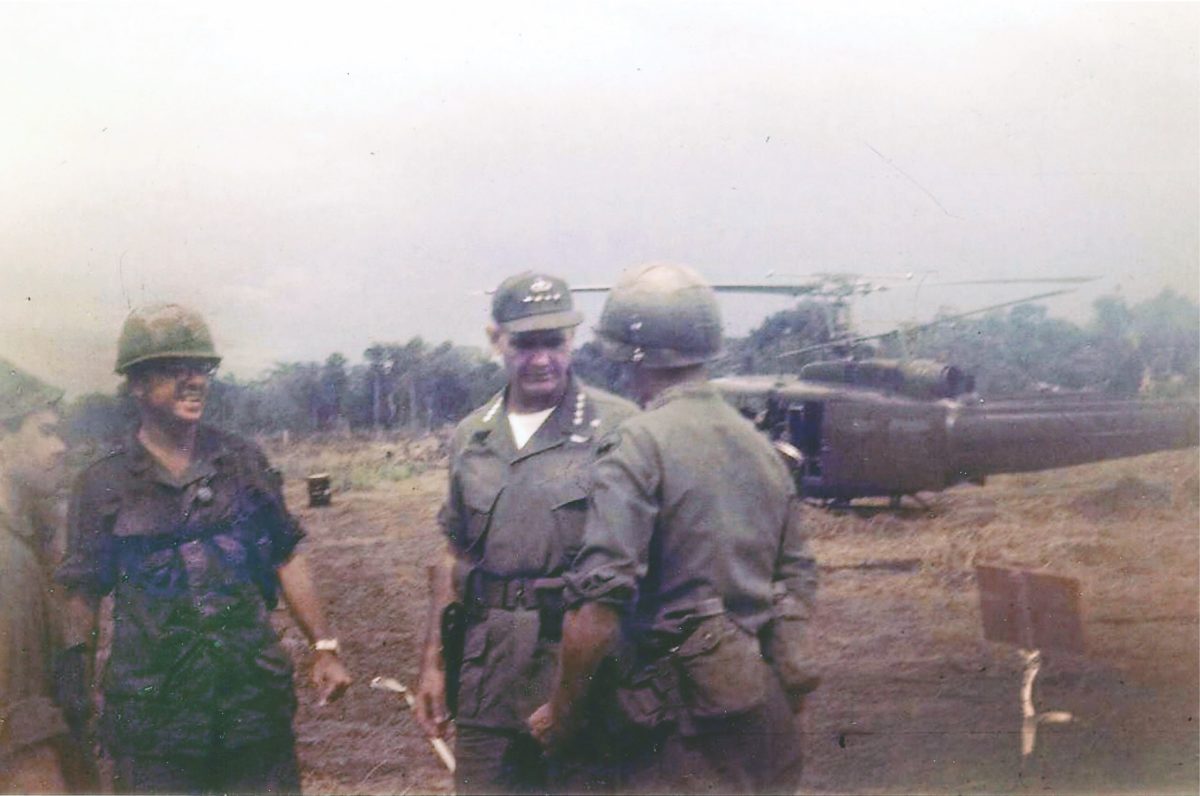On Thanksgiving Day 2018 I found myself in Vietnam, just over 50 years after I had rotated back to the United States in March 1968. Thanksgiving is just another workday in modern Vietnam, of course, but I found myself reflecting on differences between this Thanksgiving and the one in 1967, when I was in the 2nd Battalion, 47th Infantry Regiment, then part of the 9th Infantry Division’s 1st Brigade.
Since Nov. 3, 1967, the 1st Brigade had been committed to Operation Santa Fe, which also included the 1st Australian Task Force and the Army of the Republic of Vietnam’s 18th Division. Our mission was to clear out the 5th Viet Cong Division’s base in the May Tao Secret Zone, a mountainous area to the east of Saigon. We were to also secure, rebuild and reopen the 40-mile stretch of National Highway 1 from Xuan Loc, northeast of Saigon, to the boundary between the ARVN III Corps region (Saigon and the surrounding area) and II Corps (central portion of South Vietnam).
Communist forces had closed the road since 1962, and most of the stretch east of Xuan Loc ran through an area that was nearly a wilderness. Large sections of the roadbed had been destroyed, and almost all the bridges were down. As the infantry, armor and artillery secured one sector at a time, engineers followed, building and repairing.
Even though we were deep in bandit country, the U.S. Army, true to one of its most time-honored traditions, made sure we had a turkey dinner flown to us on Thanksgiving. Around that time, Gen. William Westmoreland, the commander of all U.S. combat forces in South Vietnam as head of Military Assistance Command, Vietnam, flew out to visit us. He had served in the 9th Infantry Division during World War II and during his Thanksgiving Day visit was wearing his old division’s “Octofoil” combat patch on his right shoulder. A little more than eight months later, Westmoreland’s brother-in-law, Lt. Col. Frederick Van Deusen, was killed shortly after he took command of the 2-47th Infantry. His helicopter was shot down the same day Westmoreland was sworn in as the chief of staff of the Army.
Second lieutenant is commonly thought to be the grade with the highest casualty rate in the infantry. During my battalion’s first year and a half in Vietnam, it was lieutenant colonels who had the highest casualty rate—60 percent. In addition to Van Deusen’s death, Lt. Col. Joseph Cronin was killed by sniper fire, and Lt. Col. John Leffler lost an eye and almost an arm in a helicopter accident that nearly killed him. Only Lt. Cols. Arthur Moreland and John Tower finished their command tours under their own power.
On the 2018 return to Vietnam, my wife and I drove with our tour group along Highway 1, from Saigon (now Ho Chi Minh City) through Xuan Loc and then to the coast at Phan Thiet, a total road trip of about 125 miles.

I have a personal connection to Xuan Loc. At first light on Christmas Day 1967, in the field somewhere along the Santa Fe route, I was delirious, and the medics couldn’t bring me out of it. I was medevaced to the 7th Surgical Hospital at Black Horse Base camp, a few miles from Xuan Loc. I had a severe case of malaria. (For the record, I took the anti-malaria pills religiously.)
Nothing along Highway 1 today would be recognizable to any soldier who was on Operation Santa Fe. Where there was once only wilderness, Highway 1 now carries heavy traffic all day. In some places it is a four-lane road. Almost the entire stretch to the coast is lined with houses, hotels, shops of all sorts, restaurants, malls, car dealerships, Catholic churches and Buddhist temples. I counted more than 30 gas stations along the old Santa Fe route, and a dozen karaoke bars. There is nothing much secret left in the VC’s old May Tao Secret Zone.
Before our trip to the coast, we spent several days in Saigon. Flying from Da Nang, we landed at Tan Son Nhat International Airport, which had been Tan Son Nhut Air Base and MACV headquarters. The U.S. Air Force’s Hangar 1 and Hangar 2 are still in use.
In Saigon my wife and I hired a car and driver who took us a few miles to the east, where my battalion had spent the first day of the communists’ 1968 Tet Offensive. We fought up and down Highway 1 and Highway 15, from the small town of Bien Hoa to Long Binh to Long Thanh. The U.S Air Force had a major base at Bien Hoa, and the ARVN III Corps headquarters was there. A few miles south along Highway 15 the sprawling base at Long Binh was the headquarters of U.S. Army, Vietnam. Farther down the road, close to the village of Long Thanh, was Camp Bearcat, the 9th Infantry Division’s main base.
On Jan. 30, 1968, the day before the planned start of the Tet Offensive, several communist units across the country started their attacks 24 hours too early. Consequently, all U.S. forces were placed on alert, and the Tet holiday cease-fire was canceled.
Late that afternoon our battalion’s line companies moved into positions just outside the Long Binh perimeter. At 3:05 a.m. on Jan. 31 Bien Hoa City and the air base came under mortar fire. A Company took up defensive positions on the north side of Long Binh, and B Company moved to secure the ammo dump there. My own C Company was ordered into Bien Hoa to relieve the attack on the ARVN III Corps compound. At 7:30 a.m., VC sappers managed to blow a portion of the ammo dump.
In the February 2006 issue of Vietnam, John Gross, the commander of C Company, wrote about the Jan. 31 fight. The VC moved into “Widows’ Village” across the road from the Long Binh perimeter and fired on the base. Our battalion’s Scout Platoon was sent in to clear them out—a battle that resulted in three Distinguished Service Crosses. Brice Barnes, the Scout Platoon leader, wrote about it in Vietnam’s February 2014 issue. That day the 2-47th Infantry fought against elements of the 88th North Vietnamese Army Regiment, the 274th and 275th VC regiments and the 3rd Battalion, 5th VC Regiment.
Almost nothing today was recognizable to me along Highway 15. There is no sign of the III Corps compound at Bien Hoa, which has grown into a major city. The highway is completely built-up and urbanized all the way to Long Thanh. The one-time Long Binh base is now the ultramodern Long Binh Techno Park. On the opposite side of the road is a small green park where Widows’ Village once stood.
Camp Bearcat has disappeared without a trace. It is now mostly agricultural land. I was, however, able to find two things I recognized: The rubber tree plantation just west of the perimeter is still there, and the dirt road that turns off from Long Thanh to the former Bearcat site has changed very little.
A half-century is a long time, and much more than the landscape has changed in Vietnam. After Saigon fell in 1975 and the North unified the entire country, Vietnam was a typical Stalinist state for many years. That started to change with the death in 1986 of Le Duan, the hardcore general secretary of the Central Committee of the Communist Party. Although Vietnam remains a single-party communist country under tight political control, it has opened up economically and socially. The entrepreneurial instincts of the Vietnamese can be seen throughout the country. Many people have smartphones. Internet access and Wi-Fi are available virtually everywhere. Unlike in China, Vietnam has very few restrictions on the internet. There are no limitations on religious practice, so long as religions stay out of politics. Many of the old animosities between Catholics and Buddhists seem to be gone.
Perhaps most impressively, Vietnam, unlike so many other communist countries, reveres and even glories in its pre-communist history. Historic temples and imperial sites have been restored all over the country—north and south. Even though the huge Imperial City complex in Hue was severely damaged during the 1968 Tet Offensive, most of it has been lovingly and skillfully restored, and the work is still in progress.
There was one other big difference—almost no mosquitoes. Except for a few places along the Cambodian border, Vietnam is rated as low-risk to no-risk for malaria. I wish that had been the case 50 years ago.
David T. Zabecki is editor emeritus of Vietnam magazine.
Do you have reflections on the war that you would like to share? Email your idea or article to Vietnam@HistoryNet.com, subject line: Reflections.

